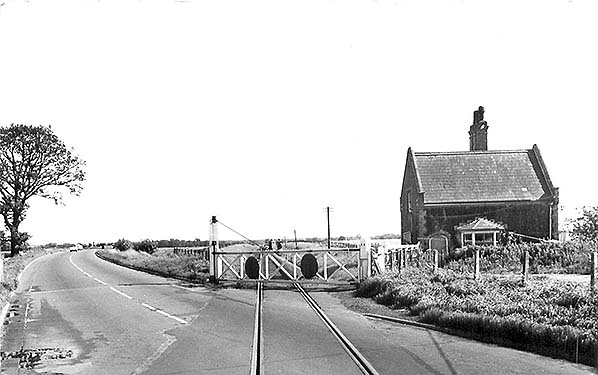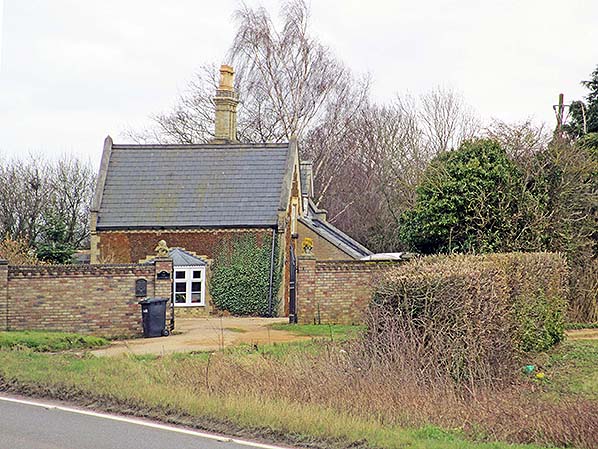Notes: Pentney and Bilney station was located a few yards short of 7 miles from Lynn. By road it was less than a mile towards Norwich from the tiny village of West Bilney. The road crossed the railway on the level just north of the station buildings. The building is extant but much extended in the years since the railway closed in 1968. The station house lay at right-angles to the running lines on the west side of the track. Like other stations on the L&D it was walled with flint supported by brick corner pieces. There was a handsome two-stack chimney.
The station’s actual name, whether Bilney or Pentney and Bilney appears to have been recorded differently from time to time. Bradshaw’s in 1850 and the Great Eastern timetable for March 1866 both show it as Bilney in their columns. Michael Quick, in 2009, wrote it up as Pentney and Bilney. Clinker’s Register of stations states that it was the longer name until 1874, but that is some eight years after closure and may be an uncharacteristic error in the register. However the location remained a level crossing and the Great Eastern may have resorted to a shorter name in its working books.

The 1885 25in OS Map does not identify the site as a station. The railway crossed the road as a single line and there is no evidence on the map of space where goods facilities might have been provided and later removed.
There are a number of references to Bilney in GER board minutes. On 29 July 1853 Mr L. S. Wells was noted as being stationmaster. This is the earliest reference to a stationmaster at Bilney so presumably Wells was there from the outset. On 27 March 1857 Mr Crisp of Bilney allowed credit of £1/9/2. This was in connection with station accounts, suggesting Crisp was the stationmaster's clerk. On 15 March 1865 a memorial from Bilney residents was received complaining about want of accommodation for passengers at West Bilney Station. The station served West Bilney but does this entry mean it was renamed to include 'West' at some point? Probably not, the mention of 'West Bilney' most likely came from the address of the sender of the memorial. 'Memorial' is an now-archaic term for a written statement of fact. On 29 March 1865 the memorial referred to above was rejected. The minutes state "Superintendent unable to recommend any additional accommodation at Bilney; memorialists to be told".

Bradshaw’s for March 1850 shows that Bilney was served equally as well as other stations in the down direction with three weekday trains leaving for Dereham at 9.09am, 12.16pm and 6.21pm: one more ran only to Swaffham at 4.20pm. Two ‘Government’ trains ran on Sundays. Up trains went to Lynn at 10.09am, 12.28pm and 6.15pm but the 4.50pm Swaffham departure missed out Bilney. Again, two Sunday trains paused at Bilney. This service may have marked something of a high spot at Bilney for, by 1866, it had joined four other intermediate stations that had become request stops.
The station building was retained after passenger trains ceased calling and presumably used to house the crossing-keeper. The gates remained hand operated.
Route map dawn by Alan Young. Tickets from Michael Stewart.
Additional source GER board minutes. Additional research by Darren Kitson.
Click here for a brief history of the Lynn & Dereham Railway
See other stations on the Lynn - Dereham line: Middleton Towers, East Winch, Narborough & Pentney, Swaffham, Sporle, Dunham, Fransham, Wendling, Scarning & Dereham (EAR Station) |




 Looking south east to the site Pentney & Bilney station in July 1982. The track passed the house on the left side.
Looking south east to the site Pentney & Bilney station in July 1982. The track passed the house on the left side.



 Home Page
Home Page